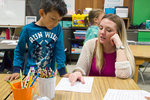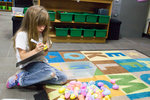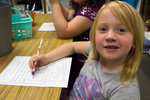


When it comes to literacy, not all students start out on an even playing field.
“We have a lot of kids who are coming in, they didn’t know their basic letters, letter names or letter sounds,” said Anne Grande, Centralia School District instructional coach. “(A)nd then if that weren’t enough, the most essential foundational skill that’s missing is vocabulary. We know that kids that come from high poverty areas come (to) us with a vocabulary deficit that is shocking.”
In an attempt to improve literacy rates for students in Centralia elementary schools, the district will implement a new English language arts curriculum this fall.
Three years ago, Grande began working with educators in the Centralia School District to improve the district’s English language arts program. She noted that the old curriculum, Journeys, was more of a textbook-based approach. The curriculum the school will implement this fall, Fountas & Pinnell Classroom, uses a “balanced literacy” approach.
“It’s a combination of very structured, very specific teaching along with student choice and engagement and lots and lots of reading time,” Grande said.
The new program was written by top literacy researchers who spent decades developing their theories, she added.
While most districts still use the textbook-based approach to English, Centralia schools will move to what is known as a workshop model, still rarely seen in area schools.
“(With) this program, in fact, we will have a lot of people coming to us to observe,” Grande said.
Although the district won’t begin using the new curriculum until the fall, teachers have already begun implementing a workshop model in the classroom — giving students more reading choices and more time to read on their own.
Kristy Vetter, Centralia School District executive director of teaching and learning, said she has already seen more enthusiasm from students who get to choose their own reading materials.
“It’s just absolutely rewarding to watch kids’ faces light up when they’re reading,” Vetter said. “That’s the kind of materials that are going to come with this program.”
The new program comes stocked with its own library of options for students. In the past, teachers have supplemented the curriculum by buying books and other materials to teach and motivate students.
“I’ve had to buy books for myself,” said Dorinda Iverson, a kindergarten teacher at Fords Prairie Elementary School. “The district did give us all $100 each here, which has been nice to be able to buy books for our student libraries. That’s really been a big help and been awesome that they have been able to give us that money.”
Iverson, who taught second grade at Fords Prairie last year, said students entering kindergarten begin the year with greater disparities in their language skills. She noted that teachers buy items such as puzzles or magnetic letters to bring the students’ skills up to speed.
Grande said the efforts showed in students’ growth, but said it placed too much responsibility on teachers.
“Our teachers that were supplementing, they were making more progress than our teachers that were trying to use our current textbook curriculum, which is a good indication that ‘okay we can do better,’ ” Grande said. “Teachers shouldn’t have to do that work on their own.”
The district hopes that by evening out learning disparities early in students’ educational careers, it can improve not only literacy rates, but graduation rates.
“The struggle for kindergarten teachers is that some kids come in knowing all their letters, their letter sounds, they can write their name,” Grande said. “Those kids, by the way, often sat on someone’s lap — mom’s lap, dad’s lap, grandpa’s lap — and they were read to from the time they were little.”
Children who are read to from a young age typically better know their letters, as well as the typical structure of a story, she said.
By third grade, it becomes more difficult for educators to equalize learning disparities.
“You can pretty much predict graduation rates,” Grande said.
Centralia School District will be one of the first districts to use this new curriculum. Starting a new program might be difficult, but it will be worth it, she said.
“It’s a lot easier for school districts to use a textbook program, because it says ‘on this date you will be here and this is the lesson you’re teaching,’” Grande said. “This program is brand new.”